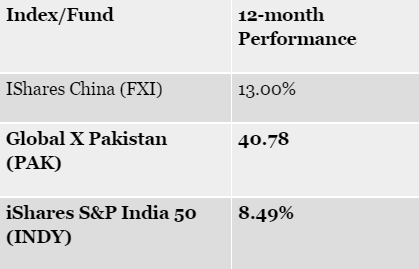Pakistan has seen extensive economic growth over the course of past twelve months. According to the data provided by MSCI Inc. (MSCI), a leading global financial services company, the country’s Exchange-Traded fund (ETF) surged ahead with 16%, leaving behind China at -1.5% and India at -3.24%. ETF is an investment fund, holds assets like stocks, commodities or bonds, traded on stock exchanges.
However, Pakistan has a lot to improve on when it comes to key macroeconomic metrics like GDP growth rates and unemployment.
After beating the regional competitors in equity markets, Pakistan beat India on another front recently: Geopolitics. The incumbent Government has successfully leveraged Pakistan’s geopolitical location to extract tons of benefits from the two global economic powers: United States and China. It is to be noted that ‘geopolitics’ has been, and will ever be, a major driving force for the country’s financial and economic sectors.
United States needed Pakistan as an ally in its most important mission on foreign land: The war against terrorism. Pakistan had agreed to offer support to fight against terrorism in exchange for the American relief for its large external debt – 60% of the country’s total GDP. In the immediate aftermath, the Paris club had cut Pakistan’s debt by $12 billion.
“A unilateral default seemed almost inevitable. However, the United States’ post-9/11 collaboration with the Musharraf government to fight terrorism provided an environment conducive for Pakistan to request the rescheduling of its debt.”
– Marko Dimitrijevic, Frontier Investor
Not even a decade ago, a confluence of domestic and external factors served to push the country in dire straits, rushing her headlong towards bankruptcy and debt-default. Economic growth had slowed, inflation had reached hyper levels, domestic and external deficits had risen to new heights.
Once again, China came along to rescue. Pak-China economic ties have kept growing and have strengthened since 1951. With the support of China, Pakistan has acquired significant importance not only in the region but the entire world. Both countries have been making substantial efforts to rebuild the historic Silk Road which is one of the oldest known business routes in the world.
China-Pakistan Economic Corridor (CPEC) is the part of China’s ‘One Belt, One Road’ or ‘OBOR’ vision. OBOR Initiative is a development policy and framework, proposed by Chinese President Xi Jinping that focuses on trade, connectivity and economic cooperation between China and the rest of Eurasia.
The One Belt one Road Project consists of three routes: southern, central and northern route. The southern route begins from Guangzhou, moves towards western parts of China and connects Kashgar with Gwadar, Pakistan. It is the shortest and the most feasible option for China. CPEC will boost Pakistan’s $274 billion GDP by over 15%.
Meanwhile, for India, CPEC is a thorn in its paw. India plans to spend $85 million in the development of Chabahar, which sits a few miles away from Gwadar and is part of its efforts for access to Afghanistan and Central Asia States while bypassing rival Pakistan. Panos Mourdoukoutas of Forbes writes.
“In a sense, Pakistan’s gain is India’s loss, as China cannot appease both countries at the same time. In fact, it has done quite the opposite: repeatedly blocking India’s efforts to join the Nuclear Supplier Group (NSG).”
– Panos Mourdoukoutas, Forbes
For Pakistan, things have improved over time: Economy is in much better shape now than it was in the aftermath of the financial crisis; rupee has strengthened as foreign investment flowed into the country, with a handful amount of it ending in financial and business sectors; the infrastructure has improved; education and health care sectors are ripe for investment; digitization, internet connectivity, and communication continue to dominate. It is good this trend is continuing, however, there is still much more progress to be made.
Photo: AP





